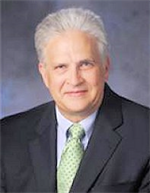 Texas A&M University alumnus Dr. Nolan E. Hertel ’73 was awarded the 2016 Distinguished Scientific Achievement Award by the Health Physics Society (HPS) to recognize his contributions to the scientific field of radiation safety and for his accomplishments regarding the practice and advancement of the profession of health physics.
Texas A&M University alumnus Dr. Nolan E. Hertel ’73 was awarded the 2016 Distinguished Scientific Achievement Award by the Health Physics Society (HPS) to recognize his contributions to the scientific field of radiation safety and for his accomplishments regarding the practice and advancement of the profession of health physics.
Hertel is a professor of nuclear and radiological engineering at Georgia Institute of Technology and is also currently serving as the interim associate chair of the Woodruff School for the Nuclear and Radiological Engineering/Medical Physics Programs. Hertel received both his bachelor’s and master’s degrees from in nuclear engineering from Texas A&M.
“When I was at Texas A&M the Bachelor of Science was only in nuclear engineering,” Hertel said. “I kind of started off in traditional engineering and it was my interest in neutron measurements that got me into this radiation protection to begin with. My master thesis research at Texas A&M was performed at the cyclotron in support of what was then a neutron radiotherapy program with M.D. Anderson. It sent me in some directions that have continued until this day.”
After his time at Texas A&M, Hertel received his Ph. D. in nuclear engineering from the University of Illinois at Urbana-Champagne in 1979. He began his career in academia shortly after as an assistant professor in the Department of Mechanical Engineering at The University of Texas at Austin. In 1993 he moved to Georgia Tech as an associate professor of nuclear engineering and health physics.
During his time at Georgia Tech, Hertel has held a variety of positions including chair of the Health Physics and Radiological Engineering Research Group, Radiological Safety Officer, director of the Neely Research Center (Georgia Tech Research Reactor), and Research Fellow of the Sam Nunn Security Program of the Georgia Tech School of International Affairs.
Hertel is best known for his research concerning neutron spectrometry, neutron interactions, radiation dosimetry, and radiation shielding. Outside of his research, he has worked with numerous organizations and programs as an expert in radiation dosimetry including NASA, the Japanese Atomic Bomb Dosimetry efforts, the International Commission on Radiological Protection, and the Department of Energy. Hertel also holds a joint faculty appointment as acting director of the Center for Radiation Protection Knowledge in the Environmental Sciences Division of Oak Ridge National Laboratory. This center serves as a common resource for six federal agencies to assist in the development and application of radiation dosimetry and risk assessment methodologies.
Despite his success, Hertel has made sure to never forget his roots.
“I look back on my time at Texas A&M with fond memories and I know I received a great education and a great start,” he said.
Contributing Author: Ryan Terry